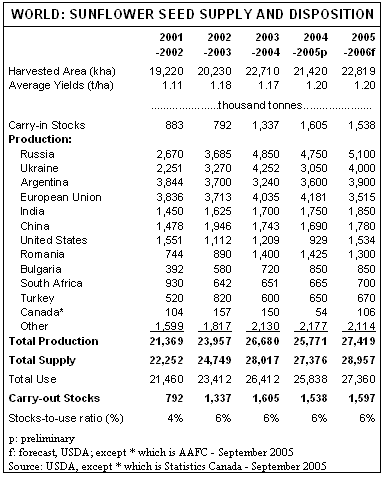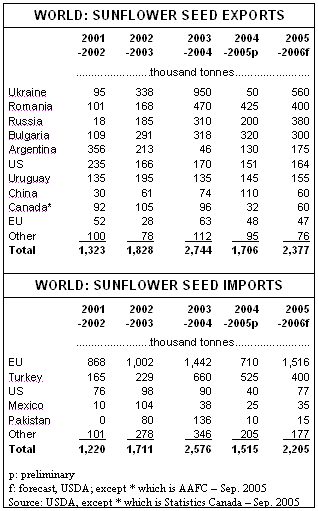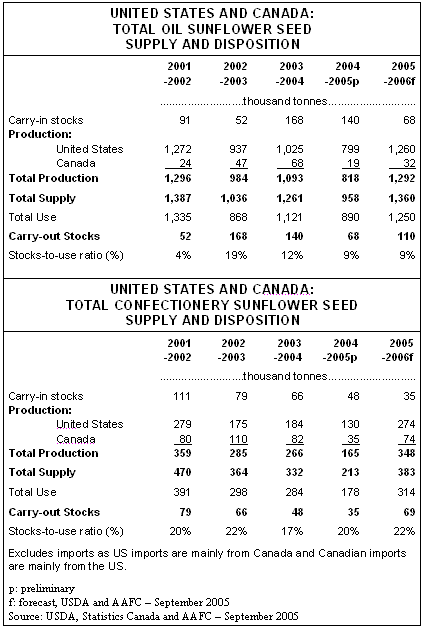Publications: Bi-weekly Bulletin
2005-09-20 | Volume 18 Number 17 | ISSN 1494-1805 | AAFC No. 2081/E
Sunflower Seed: Situation and Outlook
Canada is a major producer of confectionery sunflower seed, although Canadian production of oil sunflower seed is relatively small. There is a large value added sunflower seed processing industry in western Canada, which includes a human food market, snacks and kernels, as well as a bird seed market. The value of Canadian exports averaged at about $50 million during the past five years. For 2005-2006, Canadian production is forecast to increase from the small, weather damaged crop of 2004-2005, and the average seed quality is expected to return to normal.
World
Production and Trade
World sunflower seed production has been variable during the past ten years, ranging from a low of 21.4 million tonnes (Mt) in 2001-2002 to a high of 27.3 Mt in 1999-2000, but there has been no upward or downward trend. There are two types of sunflower seed produced, oilseed and confectionery. About 95% of world production is the oilseed type and only 5% the confectionery type.
Sunflower seed exports have been variable, in line with the variability in production, ranging from 1.32 to 2.74 Mt during the past four years. Exports are relatively dispersed, with the top 10 countries accounting for about 95% of exports. The European Union (EU) accounts for most of the imports, with Turkey, United States (US), Mexico and Pakistan accounting for most of the balance. The US and Canada are the main exporters of confectionery sunflower seeds, with the EU and Mexico being the main destinations, excluding trade between Canada and the US.
Canada
Production
Sunflowers grow best on loam, silty loam, and silty clay loam soils with good drainage. They have a low tolerance for saline conditions; therefore soils with moderate to high levels of salinity should be avoided. Sunflowers have a deep tap root that can obtain water and nutrients 1.5-1.8 metres (5-6 feet) deep in the soil. These reserves of water and nutrients are unavailable to most other annual crops, making sunflowers a good rotational crop. Sunflowers should be seeded as early as possible, usually in the first half of May, since they require 115-125 days to reach maturity.
Canadian sunflower seed production fell sharply in the mid-1990s when crushing ended in Canada. However, production has been trending upwards since 1998-1999 with most of the increase for the confectionery type, which has become the main type produced. Manitoba accounts for most of the production, followed by Saskatchewan, Alberta and Ontario. The main producing areas are south-central Manitoba, south-western Manitoba and south-eastern Saskatchewan. The Canadian sunflower seed harvest occurs mainly in October.
NuSun
NuSun is a mid-oleic (monounsaturated fatty acid) sunflower seed which has a low saturated fat profile. The oleic acid content of NuSun oil is about 65% compared to 16% for traditional sunflower oil, this compares well with 61% for canola oil and 23% for soybean oil. Oil produced from NuSun hybrids contains about 65% monounsaturated fat, 26% polyunsaturated fat and 9% saturated fat, which is considered to be the optimum fat balance under current dietary fat recommendations. The 72% linoleic acid content of oil from traditional hybrids has been reduced to 26%, which means that hydrogenation, bubbling hydrogen into the oil, is not necessary for oil produced from NuSun hybrids. Since there is no hydrogenation, there is no formation of trans fatty acids. The high oleic acid and low saturated fat profile is believed to lower cholesterol and the risk of coronary heart disease
There are several advantages to NuSun oil. First, the costs of hydrogenation are avoided since it holds up longer in frying vats without flavour deterioration. Second, trans fatty acids, which are considered to be unhealthy, are not present because there is no hydrogenation. Third, end user costs are lower since it is not necessary to replace the oil as frequently during frying as with other vegetable oils. Finally, at frying temperatures, NuSun oil produces more flavour-stable snack food.
Commercial production of NuSun hybrids started in the US in 1998 and has increased significantly since then to meet market demand. The development of NuSun has shifted sunflower oil use in the US to domestic markets from export markets. NuSun hybrids are also produced in Canada.
Sunola and Sunwheat
Shorter season oilseed type varieties have been developed for areas where the traditional hybrids cannot be grown. They have the further advantage of being able to be sown and harvested with the same equipment as cereal grains or canola, whereas the traditional hybrids require specialized equipment. Sunola is a miniature, open pollinated sunflower, which requires 99-103 days to maturity. The oil content is equal to sunflower hybrids. Sunwheat is a dwarf hybrid sunflower and requires 100-110 days to maturity. Its oil content is slightly lower than Sunola. It is more suited to the arid areas and able to withstand periods of summer heat better than some other crops. Both Sunola and Sunwheat have lower yields than traditional hybrids.
Marketing
Sunflower seed is sold on the open market to dealers located mostly in Manitoba. Sunflower seed is shipped bulk in trucks or rail cars. Some sunflower seed is grown under production contracts which guarantee a price for part of the production.
The Canadian Special Crops Association (CSCA) (www.specialcrops.mb.ca) establishes trade rules for domestic trade and serves as a forum for exporters, dealers and brokers involved in the industry of trading Canada's pulse and special crops, including sunflower seed. The website includes a section where buyers can submit a request for prices.
The Canadian Grain Commission (CGC) administers quality control standards for sunflower seed. There are two grades for each type of sunflower seed. In addition, sunflower seed can be graded "Sample" if it does not meet the specifications for the two grades. For further information, or to access the Official Grain Grading Guide, please visit the CGC website: (www.grainscanada.gc.ca)
Use
The majority of the oil sunflower seeds in the world are crushed after the hull is removed. The hull represents about 15% of the sunflower seed weight. Dehulled seed yields 45-50% oil and 50-55% meal. The oil is used for frying or to produce salad dressing, shortening and margarine. The mid and high oleic hybrids produce oil for specialized markets. The meal is used as a protein supplement in livestock feed and usually contains about 35% protein. The hulls are used mostly for livestock bedding, with some used as a source of fibre for cattle feed. Use of oil sunflower seed by the bird seed industry is growing. In Canada, the majority of the oilseed type seed is used by the bird seed industry.
Confectionery type sunflower seeds are used in the snack food industry as roasted sunflower seeds and dehulled for use in snack food and baking. Sunflower seeds are high in protein, calcium, phosphorous, iron, potassium, and vitamin E. The sunflower seed snacks are usually lightly coated in salt or spices. Some confectionery sunflower seeds are also used for bird seed.
Less frequently, sunflower seeds are used for cattle feed. Usually damaged seed is used, but good quality seed is sometimes used in dairy cattle rations.
Canadian domestic use, which includes food, feed, seed, dockage and waste, has been trending upwards in line with the growth in production and domestic processing. Since 1995, sunflower seeds have not been crushed in Canada, but the crush use has been replaced by increased processing of confectionery sunflower seed and increased use for bird seed. The markets for in-shell snack food, dehulled snack food, baking and bird seed have increased significantly.
Exports
The majority of Canadian sunflower seeds exports are to the US, with the balance going mostly to Europe, Latin America, the Middle East and northern Africa. Exports to the US are both oilseed and confectionery types, while exports to other parts of the world are mainly the confectionery type. In addition to the seed, prepackaged snack food, dehulled sunflower seed and bird seed are also exported.
Prices
In general, Canadian sunflower seed prices follow US prices adjusted by exchange rates. Oilseed sunflower prices are affected by the supply and demand factors for vegetable oil and protein meal. Confectionery sunflower seed prices depend on supply and demand conditions in the confectionery market. Bird seed sunflower prices mostly follow the prices of the oilseed type. Top grade prices of both confectionery and oilseed types increased in 2004-2005, as compared to 2003-2004, with the sharpest increase for the confectionery type.
In general, the top grade seed available was carried over from 2003-2004, as the quality of the 2004-2005 seed was damaged by wet weather, frost and disease, especially for the confectionery type.
Outlook: 2005-2006
World
Total world sunflower seed production and supply are forecast to increase by 6% to 27.4 Mt and 29.0 Mt, respectively. Total use is expected to increase due to the higher supply and stronger demand, and carry-out stocks are forecast to increase only slightly, with the stocks-to-use ratio remaining at 6%.
United States
US sunflower seed production is forecast to increase by 65% to 1.53 Mt, because of an increase in seeded area, lower abandonment and higher yields. Total supply is forecast to increase by 49% to 1.62 Mt, due to lower carry-in stocks. Oil sunflower seed production is forecast to increase by 58% to 1.26 Mt and supply to increase by 43% to 1.32 Mt. Confectionery sunflower seed production is forecast to double to 274,000 t and supply to increase by 83% to 299,000 t.
Canada
Canadian sunflower seed production is forecast to more than double to 106,000 tonnes (t) due to an increase in seeded area, lower abandonment and higher yields. Average quality is expected to return to normal. Oilseed type production is forecast to nearly double to 32,000 t, while confectionery type production is forecast to more than double to 74,000 t. Total supply is forecast to grow by 35% to 154,000 t, due to lower carry-in stocks. Exports and domestic use are expected to increase, due to higher supply and strong demand. Carry-out stocks are forecast to increase to 20,000 t, with a stocks-to-use ratio of 15%.
Total Canada and United States
Oil sunflower seed production is forecast to increase by 58% to 1.29 Mt and supply to increase by 42% to 1.36 Mt. Confectionery sunflower seed production is forecast to more than double to 348,000 t and supply to increase by 80% to 383,000 t.
Prices
For both types, the average Canadian price is forecast to decrease from 2004-2005 due to higher supply.
Outlook: Canada Longer Term
Production of confectionery sunflower seed is expected to grow moderately in line with the growth in demand. Sunflower seed is considered to be healthy food and the industry has been developing new products, such as spreads and snacks made from sunflower seed kernels, which are expected to increase demand.
Oil sunflower seed production is also expected to grow, but the rate of increase will depend on the price of vegetable oil as well as the growth in demand for bird seed. An additional factor is the growth in demand for NuSun. A continuing strong increase in demand for NuSun oil and attractive prices could result in a faster increase in Canadian oil sunflower seed production and possibly a return to sunflower seed crushing in Canada.
The demand for NuSun oil is expected to continue growing especially in the snack food market and the fast food industry, as well as in the salad and home use markets. The trend to labeling regulations which list the amount of trans fatty acids will contribute to the growth in demand.
Research is underway to develop hybrids that are tolerant to sclerotinia, the most devastating disease of sunflowers. Sclerotinia tolerant hybrids would decrease the risk of producing sunflower seed and improve producers' financial returns.
US Farm Security and Rural Investment Act of 2002 (FSRIA)
Under the FSRIA, for crop years 2004-2007, the loan rate is US$0.093 /lb, based on prices for the oilseed type, compared to US$0.096 /lb for 2002 and 2003. These rates are for the top grade and there are discounts for lower quality seed. The loan rate varies by county. The loan rate provides a floor return because if the price is lower than the loan rate, the producer is eligible for a loan deficiency payment (LDP). Since the LDP for the confectionery type is the same as for the oilseed type, the confectionery type prices are not used in determining the LDP. Sunflower seed is also eligible for the minor oilseeds direct payment of US$0.008 /lb. However, this is based on historical seeded area and yields, and is theoretically decoupled from the area seeded during the year of the payout. Sunflower seed is eligible for the minor oilseeds counter-cyclical payments (CCP) based on the target price of US$0.098 /lb for crop years 2002 and 2003, and US$0.101 /lb for crop years 2004 to 2007. However, in calculating the CCP, the direct payment is first deducted from the target price. Therefore, since the target price minus the direct payment is less or equal to the loan rate or market price, no counter cyclical payment is expected for sunflower seed.
LDP under FSRIA have been relatively small because prices have generally been higher than the loan rate. Therefore, the main benefit of the loan program has been that it provides a floor return, which supports sunflower seed planting especially in years when prices of alternative crops are low. The support for higher planting contributes to higher supply, which pressures Canadian prices downward.
by
While the Market Analysis Division assumes responsibility for all information contained in this bulletin, we wish to gratefully acknowledge input from the following: Canadian Special Crops Association, Manitoba Agriculture, Food and Rural Initiatives, National Sunflower Association of Canada, Market and Industry Services Branch (AAFC)
|
|
||
| Date Modified: 2006-12-08 |
|
|
|
[ Français | Contact Us | Help | Search | Canada Site ] [ AAFC Online | Links | Newsroom | What's New | Site Index ] |
||




